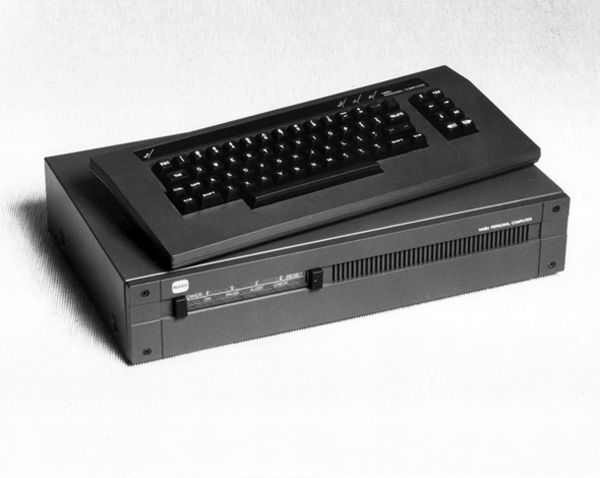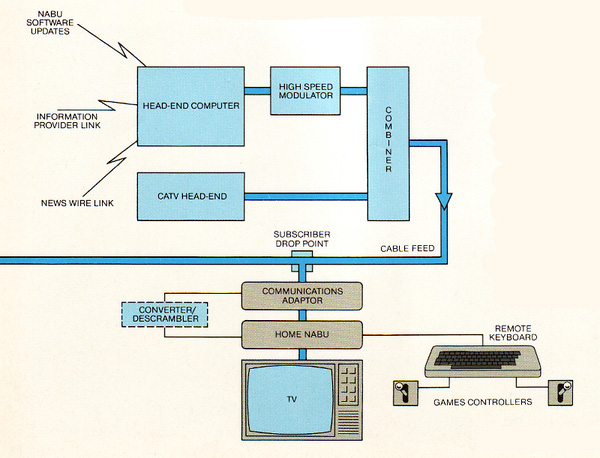In the early 1980s, several companies explored market potential for providing software to home computer owners via TV cable (CATV) without compromising existing TV services. These companies maintained that cable networks would come into general use as a major medium through which software would be made available to the software-consuming public.
More about the NABU Network:
The NABU Network was possibly the most advanced and foremost among the early electronic delivery of software services. It was a brainchild of a Canadian entrepreneur John Kelly. The NABU Manufacturing, which would spawn the NABU Network, was incorporated in June 1981. Kelly lured top engineering and managerial talent away from several of the leading companies on the high tech scene to join NABU. Denzil J (Denny) Doyle left the presidency of Digital Equipment Corporation’s Canadian subsidiary which he had established in 1963, to become NABU’s first president and CEO.
Release Information:
NABU announced its network during the 1982 National Cable & Telecommunications Association Conference in Las Vegas. In May 1983, NABU transmitted its programming via satellite from Ottawa to terminals installed at the 26th Annual Convention of the Canadian Cable Television Association in Calgary.
The transmission used the ANIK-D1 satellite, and it was a live feed from Ottawa. On 15 October 1983, the NABU Network was launched on Ottawa Cablevision, an 85,000-subscriber company where much of NABU’s testing was performed. Soon thereafter, the network made its US debut in Alexandria, Virginia, on Tribune Cable, a 5,000 subscriber service.

The NABU Network:
To access NABU Network, customers had to purchase or rent a NABU PC computer and a network adaptor. The network operated by broadcasting software and data from a high-speed head-end computer to every authorized subscriber on a dedicated cable channel.

Once the NABU PC was connected to the adaptor and turned on, it requested from the adaptor two software items to be located on the network and sent to the user’s computer. One was the downloadable operating system (or DOS). The other was the Main Menu software that allowed a user to navigate the network and to select and download the selected items. The adaptor was continuously receiving the NABU channel and as soon as the requested software was available, it transmitted it to the PC. In short, the adaptor was responding to user’s requests for downloading data and applications programs from the cable.
The network offered its subscribers software and information in a range of categories, including entertainment, education, family information, home management, and a network guide. The November-December 1984 issue of The NABU Network magazine lists over 140 titles available on Ottawa Cablevision’s NABU Network. In Ottawa, NABU program listings were available online (on NABU’s Network Guide) as well as in local newspapers and NABU publications. Dedicated NABU magazines, newsletters, programming guides, and user groups provided subscribers with supplementary information and support.
NABU’s long-term objective was to develop a global North American network in three phases. The first phase emphasized one-way transmission from the head-end computer down to the subscribers’ PCs. Phase two was the development of a two-way NABU service within a single provider community. The third and most far-reaching phase was to feature a North America-wide web of interconnected NABU services. The head-end computers of different CATV providers were to be interconnected via satellite with each other, with externally located data bases, and with anyone else who wished to communicate via the NABU Network.
So what happened to the NABU Network?
Unfortunately, because of financial difficulties, the NABU Network went off the air on 31 August 1986 in both Ottawa and Alexandria before phase two of NABU’s business plan was implemented. Described as “the most innovative, daring, and least appreciated venture in the Canadian computer and communications industries” by some (D. Thomas), and “the `Internet’ — ten years ahead of its time” check this link, the NABU Network was an innovative attempt to radically reshape the principles of personal computer-based public access to information and entertainment.
Source: York University Computer Museum